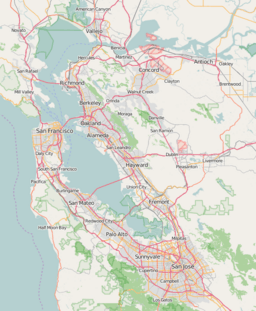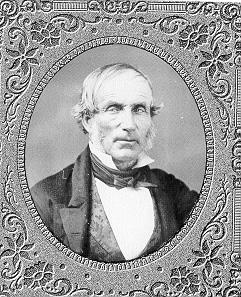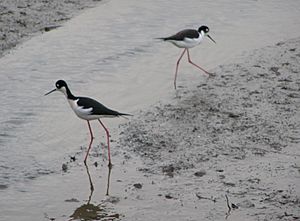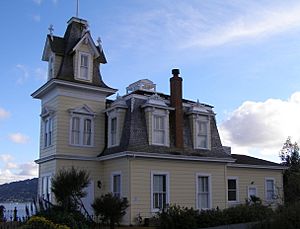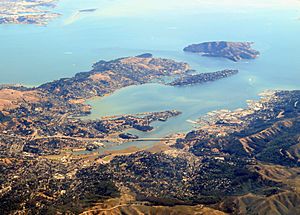Richardson Bay facts for kids
Quick facts for kids Richardson Bay |
|
|---|---|
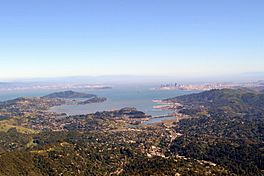
Richardson Bay viewed from Mount Tamalpais
|
|
| Location | San Francisco Bay |
| Coordinates | 37°52′30″N 122°29′00″W / 37.87500°N 122.48333°W |
| Type | Bay |
| Etymology | William A. Richardson |
| Primary inflows | Arroyo Corte Madera del Presidio, Coyote Creek |
| Average depth | 20 ft (6.1 m) |
Richardson Bay is a beautiful, shallow part of San Francisco Bay. It's a very important natural area. Four cities in northern California work together to manage it.
The National Audubon Society bought the 911-acre (369 ha) Richardson Bay Sanctuary in the early 1960s. The bay is named after William A. Richardson. He was a sea captain and builder in San Francisco in the 1800s. The bay includes two islands, Strawberry Spit and Aramburu Island.
Even though there are cities around it, Richardson Bay has lots of eelgrass and untouched mudflats. These areas are important feeding and resting spots for many birds. These birds live in or near estuaries (where fresh and salt water mix) and the open ocean. The marshes and shorelines around the bay also support many different animals and plants.
Richardson Bay is known as an Important Bird Area (IBA). This is because so many birds visit or live there each year. It's also a key stop on their migration paths. Rare birds like the California clapper rail have been seen here. To protect its delicate environment, no boats are allowed to dump waste into the bay. This helps keep the fishery, shellfish, and even marine mammals like harbor seals safe.
Because the bay is shallow and has tricky channels, it's mostly used for kayaking and small sailing boats. There are also many hiking and bicycling paths around the bay. You can find these paths especially near the towns of Mill Valley and Tiburon.
Contents
How Richardson Bay Got Its Name
The bay is named after William A. Richardson. He was an English whaler captain. In 1822, his ship, the Orion, stopped in San Francisco. He met Maria Antonia, whose father was a commander at the Presidio of San Francisco.
Maria's father, Ygnacio Martinez, invited Captain Richardson to live with their family. Martinez, by the way, is who the town of Martinez is named after. William Richardson joined the Catholic Church and was baptized "Guillermo Antonio Richardson." He and Maria got married in 1826 at Mission Dolores. This was a very important wedding, as it was one of the first big Spanish-Anglo Saxon weddings in North America.
Richardson taught carpentry, boat building, and navigation at Mission Dolores. He also became the Captain of the Port of San Francisco. He built the first important house in San Francisco, which was meant to be a trading post. He also managed several schooners for the missions.
In 1838, Richardson received a large Mexican land grant called Rancho Saucelito. This land included everything north of the Golden Gate from the bay to the ocean. It stretched north to Mount Tamalpais and included areas like Redwood Canyon and Muir Woods National Monument. Because of his important role as an early settler and builder, Richardson Bay was named in his honor.
The Tiburon Peninsula, on the northeast side of the bay, was part of another land grant. This was Rancho Corte Madera del Presidio, given to John Thomas Reed in 1834.
Originally, the bay was called Richardson's Bay. But the United States Board on Geographic Names usually removes apostrophes from place names in the U.S. That's why it's now officially called Richardson Bay on maps and in government records.
The Land Beneath Richardson Bay
Richardson Bay sits on layers of clay, silt, and some sand and gravel. These materials were laid down by the ocean and estuaries over time. The soft "bay muds" are found all over San Francisco Bay. In Richardson Bay, these muds are about 80 to 95 feet (24 to 30 meters) deep. They are less than 10,000 years old.
Underneath the muds are firmer soils with two layers of sand. Below that is shale from the Franciscan Complex. This complex is a mix of different kinds of rocks. These rocks were formed over millions of years as the Earth's plates moved.
Wildlife and Plants in Richardson Bay

Richardson Bay is a very important ecological area. The Audubon California manages it as the Richardson Bay Audubon Center & Sanctuary. It has rich estuary resources, many birds, mammals, and marsh plants.
Bird Life in the Bay
Birds are everywhere in Richardson Bay! Over a million migratory birds visit each winter. Many of them use the mudflats and Bothin Marsh near U.S. Route 101. Besides being an Important Bird Area, Richardson Bay is also a Hemispheric Reserve for shorebirds.
Birds that spend winter here include least sandpipers, western sandpipers, spotted sandpipers, American avocets, dunlins, marbled godwits, greater yellowlegs, willets, long-billed curlews, and dowitchers. A special bird that lives here year-round is the California clapper rail. This bird is an endangered species. Since 2014, endangered black oystercatchers have also been seen nesting on Aramburu Island.
Common birds that live in the Richardson Bay Sanctuary all year include great blue herons, snowy egrets, and great egrets. You'll also see mallards, red-tailed hawks, and turkey vultures. Other common residents are killdeer, western gulls, mourning doves, and rock doves. You might also spot Anna's hummingbirds. Smaller birds like scrub jays, American crows, chestnut-backed chickadees, bushtits, Bewick's wrens, house sparrows, red-winged blackbirds, house finches, California towhees, and song sparrows are also common.
Fish and Shellfish
Richardson Bay is home to a Pacific herring fishery and oyster beds. The boats that catch herring for all of San Francisco Bay are based in Sausalito harbor in Richardson Bay. The California Department of Fish and Game watches over this fishing. The number of herring has been going down, but not because of too much fishing. It's more likely due to ocean environmental factors.
Herring spend most of their lives in the open ocean. They come to Richardson Bay and other estuaries in winter to lay their eggs in the shallow, protected waters. In Richardson Bay, their eggs stick to surfaces like eelgrass, piers, or rocks. After the eggs hatch, the baby herring eat plankton. Before hatching, the eggs can be eaten by gulls at low tide or by sturgeon and other animals at high tide.
There's also a special project for oysters. Scientists are placing bags of old oyster shells underwater. These shells act as places for young oysters to attach and grow. This helps the native oyster population. Oysters in the bay can be eaten by bat rays and certain crabs.
Tiny Creatures in the Mudflats
The large mudflats in Richardson Bay are a rich home for many marine invertebrates (animals without backbones). Many of these creatures are found elsewhere in San Francisco Bay. You can find burrowing clams, polychaete worms, crustaceans like crabs, amphipods, and anemones.
Surveys of the mudflats have found many different species. These include various bivalves (like clams and mussels), sea snails, crabs, isopods, barnacles, and more types of anemones.
Marine Mammals
Harbor seals visit Richardson Bay. They often rest on DeSilva Island and along the Tiburon shore near the Audubon Sanctuary. The endangered salt marsh harvest mouse is also believed to live here.
Plants of the Bay
The plants in Richardson Bay include those that live in the intertidal areas (covered by water at high tide, exposed at low tide) and on higher land. One of the most important plants is the large amount of eelgrass. The eelgrass in Richardson Bay is one of the biggest groups in Northern California. Efforts are being made to restore it, which helps expand this important habitat.
There's also a lot of pickleweed at the western end of the bay. This plant grows in the mudflat areas that are exposed at low tide. On the higher land around Richardson Bay, you can find plants like toyon, coast live oak, California bay, and native California bunch grasses.
In November 2007, there was a big oil spill in the San Francisco Bay. This spill, called the Cosco Busan oil spill, harmed herring fry (baby herring) in Richardson Bay. It greatly affected many living things in the bay.
Modern History of Richardson Bay
In the late 1800s and early 1900s, the land around Richardson Bay was divided into many smaller pieces. These pieces became public and private properties. The cities of Tiburon, Mill Valley, Belvedere, and Sausalito have rules to protect the shoreline of Richardson Bay. Even with these rules, a lot of building has happened over the years. The Audubon Society manages the Richardson Bay Sanctuary. They work with the four nearby cities to protect the area.
One piece of land was given to Rosie Verall, who worked for the Reed family. This land, about 13 acres (5.3 ha), is now the main part of the Audubon Richardson Bay Sanctuary. Verall donated this land to be a permanent wildlife sanctuary. In 1960, the Audubon Society bought this land and all the underwater and intertidal lands of Richardson Bay. The Lyford House, built in 1876, is on the Verall parcel. The house is decorated in the style of that time and is used by the National Audubon Society for special events.
Water Flow and Boating in the Bay

Richardson Bay connects to San Francisco Bay where the water depth reaches 20 feet (6 m). This boundary is a bit uneven and connects the southern end of the Sausalito Marina to the southern tip of Belvedere. At this point, the water quickly gets much deeper, reaching 100 feet (30 m) almost right away on the San Francisco Bay side. This part of San Francisco Bay, also called Raccoon Strait, has very strong and choppy waters.
Boating in Richardson Bay is mostly for small sailing boats and kayaks because the water isn't very deep. Also, nearly 900 acres of the bay are closed for six months each winter. This closure helps protect the bay's natural system, especially the migratory waterbirds.
Richardson Bay gets water from many small streams that flow only during certain seasons. It also gets water from three main streams: Arroyo Corte Madera del Presidio, Pickleweed Inlet, and Coyote Creek (Marin County). These streams flow into Richardson Bay from the northwest. Arroyo Corte Madera del Presidio and Coyote Creek don't always have water flowing in them.
Richardson Bay Audubon Center & Sanctuary
The National Audubon Society runs a nature center in Tiburon. They offer nature programs for both kids and adults. These programs include summer camps, school science lessons, birthday parties, family events, and guided walks. They also have workshops on environmental education and volunteer projects. Recently, they worked to improve the human-made islands of Aramburu, Pickleweed, and Unnamed. This helps make them even better places for birds to live.
See also
 In Spanish: Bahía de Richardson para niños
In Spanish: Bahía de Richardson para niños


